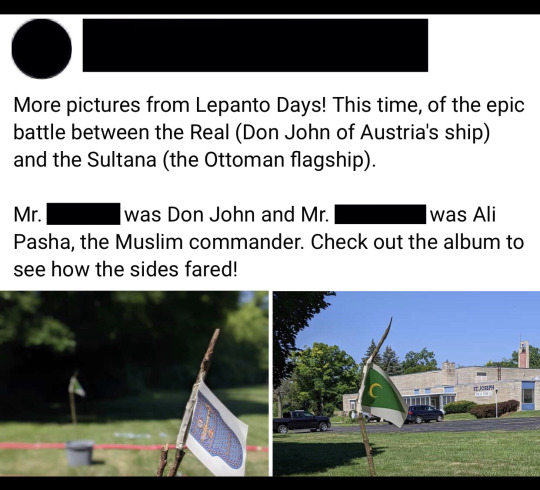#Lepanto-class
Text
the tradcath religion teacher from my high school who basically traumatized my graduating class left the school. his reasoning? the school wasn’t “catholic enough”. he left to form his own catholic school.
the only word i can use to describe this school’s curriculum is batshit.
he’s opted to combine math and science into one class so he can include theater history as a required credit. there are three religion classes, mass every day, and the history curriculum is questionable at best. Don’t believe me?

why are the 5th graders roleplaying the battle of lepanto? why are you this deep into the history of the holy roman empire in the 5th grade? don’t you think there’s more important historical events to cover in the 5th grade? given the bs that was taught to me when you were teaching at my school, i doubt you’re covering this topic in an unbiased manner.
the icing on the cake? the website for this school describes the academy as “catholic in spirit” and “independent in nature”. this is code-phrase for “our school wasn’t accepted into the local catholic diocese because it doesn’t meet the requirements”. he confirmed in a local tv interview that his school wasn’t confirmed by the diocese— which means it’s not even a catholic school in the eyes of the church.
the man created a private school for his personal, ultra-conservative version of catholicism— a version so traditionalist it wasn’t accepted by the actual catholic system
this is a cult school, straight up. the lesson plans for this school just completely omit critical parts of the national curriculum in order to give more time to religious indoctrination. this is beyond the harm normal catholic schools do. have you ever even heard of a school that combines math and science into one class? there’s no way the kids going to this school are getting anywhere near the education they need.
anyways, anyone else have to deal w their old religion teacher turning into a cult leader? 🙃
#realizing what a wild ride this must be from an outside perspective lmao#|| the disciple ||#ex catholic#ex christian#ex cult#exvangelical#ex religious#catholic guilt#atheist#religious trauma#religious guilt#catholic trauma#ex fundie#apostate#apostasy#ex fundamentalist#deconversion#deconvert#leaving the church
79 notes
·
View notes
Video
youtube
About Salamis-class,Magellan-class,Lepanto-class, Columbus-class,Saberfish,Recon Type Saberfish "Duckbill" commentary of mobile suit Gundam THE ORIGIN.
0 notes
Text
Napoli: controlli dei Carabinieri, sicurezza nel quartiere e presenza visibile, due persone arrestate e 3 denunciate.

Napoli: controlli dei Carabinieri, sicurezza nel quartiere e presenza visibile, due persone arrestate e 3 denunciate.
I carabinieri della compagnia di Bagnoli, su impulso del Comando Provinciale di Napoli, stanno intensificando i presidi sul territorio. Massima attenzione lungo viale Augusto, teatro del recente ferimento, via Leopardi e via Lepanto, strade molto affollate del quartiere.
Arrestati G.P, classe 91 e il 39enne D. M..
Dovranno rispondere di detenzione di droga a fini di spaccio. Sono stati sorpresi in un seminterrato in via Marco Aurelio, nel locale 8 grammi di cocaina già dosati e due bilancini di precisione e contanti, circa 300 euro ritenuti del provento illecito. Sono ora ai domiciliari in attesa di giudizio.
Due le persone denunciate per evasione. Entrambi sottoposti ai domiciliari, sono stati individuati in strada, senza alcuna autorizzazione.
Nei guai anche un parcheggiatore abusivo, già destinatario di un ammonimento.
E 4 giovanissimi nelle cui tasche c'erano piccole dosi di droga sono stati sanzionati amministrativamente.
Non sono mancate le contravvenzioni al codice della strada: 7 i veicoli posti sotto sequestro, decine le multe notificate.
I controlli continueranno anche nei prossimi giorni....
#notizie #news #breakingnews #cronaca #politica #eventi #sport #moda
Read the full article
0 notes
Text
It was a chilly evening at Cebu.
Krista let me meet a guy friend - I can’t even remember his name.
We met up that night for a dinner and to do some sight seeing.
I just passed my comprehensive exam and I feel light and wobbly.
It feels surreal and somehow it made me feel lost.
I was supposed to be happy — but why am I not at peace?
-
I was on the MRT to/from trinoma (can’t exactly remember) but I just passed the entrance exam at PGH.
I was happy and excited. I am looking forward to working at a hospital.
-
I was inside a cinema watching now you see me when I officially passed the practicals of dental licensure exam.
I was too bothered to care, because at the back of my mind, I know I’ll pass.
-
I saw him come out of that white car i’ve been eye-ing for quite a while.
It made me feel excited.
And thought that there might be some telenovela future for us.
He was exactly my type at that point in time.
I always feel nervous every time he is around.
When they call my name at CC. When mic would drag me to CC.
In my own little world, it was very exciting.
That time he came by at my dorm.
I was really happy.
Remembering all these still makes me feel happy.
-
It’s not always good. Reality had sticked hard.
I cut off his photos.
I saw him bring another girl to meet his family.
I read how that girl has become close to his sister.
How he never told me the name of his dog.
How he just stopped talking to me.
How I always thought and hoped that there might be or could be more between us.
-
Here’s come the story of that guy who I thought I’ll spend my life with.
I can’t believe how naive i was.
He will wait for me at the FX terminal wearing really cool clothes and he smelled good.
I will tell my parents that I need to be at the university full day so I can spend the early morning with him.
Our first kiss, it was wet. His eyes were closed.
His breath smelled like mint toothpaste.
It’s full of curiosity.
It was a random weekend afternoon.
Then i made a dramatic exit. We fought about it.
We also made out at my mom’s clinic. We kissed.
-
The day he officially broke up with me, it was on the phone.
Then he literally just stopped talking to me.
My friend had to message him so we can talk in person before officially ending things.
His eyes were so cold.
He can’t even look at me straight.
We were at the food court.
I ordered the usual food.
But I can’t bring myself to eat it.
I was begging.
I was crying.
I was telling him to fix this.
When we finished eating, I can’t seem to part ways and accept the reality.
I walked around nonstop from gastambide. To lepanto.
And he was following me.
I thought it was a good sign.
But it’s him clearing his conscience that i will be safe.
And we will part in good way.
I kept on asking him to take him back.
And he was saying no.
I was crying and crying.
I think i went back to class and i cannot remember what happened the rest of the day.
0 notes
Photo










#Gundam ZZ#Quin Mantha#Gundam Seed#Flay Allster#Gundam Thunderbolt#Full Armor Gundam (Thunderbolt Ver.)#Mobile Suit Gundam Side Story: The Blue Destiny#Blue Destiny Unit 1#Gundam Unicorn#Stark Jegan#ZZ Gundam#Mobile Suit Zeta Gundam#Marasai#MS IGLOO#Jotunheim#Gundam: The Origin#Lepanto-class#Gundam MS IGLOO 2: The Gravity Front#Type 61 Tank#Mobile Suit Gundam: The 08th MS Team
130 notes
·
View notes
Text
omg today is lepanto day
#a friend of mine used to make cupcakes in HS for our class on lepanto day#and our English teacher did a dramatic reading of the GK Chesterton poem
8 notes
·
View notes
Text
The Unity of Truth, Goodness, and Beauty, Or Is Judas the Original Social Justice Warrior?
About a month ago over at the Lepanto Institute Facebook page, a meme was posted. You can see it here. It pictures an almost offensively stereotypically Jewish Judas kissing a rather European looking Jesus Christ Artist . At the top in ominous, red letters it says, Judas Iscariot; at the bottom (oddly in white), Patron Saint of Social Justice. Scot Eric Alt and Mary Pezzulo adequately explained and criticized this: “Lepanto Institute Meme Attempts to Link Social Justice to Judas Iscariot,” “The Lepanto Institute and the Sin of Judas,” and “Lepanto Institute Under Malicious Attack by Evil “Social Justice Warriors”!”

I thought things were done, then I cam across this piece by Steven Skojec over at 1Peter5 (an odd, to me, Catholic site). Skojec describes Pope Francis as wearing some kind of mask (as if, perhaps, he’s really just a front for a demon and the Devil/Antichrist really now is the Pope in Rome as so many of my fundamentalist, dispensationalist Protestant friends used to tell me). Skojec’s article is strange enough. But then I read the comments. Two people, in conjunction with one another, regarded Pope Francis, SJW, as Judas’ pope. One commenter went so far as to suggest there were “excellent parallels” between Pope Francis and Judas, both, the commenter notes, Social Justice Warriors.
Now, I don’t want to beat a dead horse. But let’s do be reminded of the context for this claim. While the anointing of Jesus’ feet with expensive perfume is described in three gospels, it is only in John’s that we are told it was Judas complaining. And also in John are we reminded that Judas did not actually care about the poor, but used shared purse as his personal purse, purloining coins whene’er he could. So, the context makes it clear, Judas’ goals are not social justice, but personal gain. But, what if Judas did really want to help the poor? I mean, let’s remember that two other gospels merely tell us that some of the disciples complained about the woman’s actions suggesting that they could have sold the perfume and aided the poor. On the face of it, we could easily read them as passages about “social justice.”
This is where a video from back in November featuring Dr. Conor Cunningham, of my alma mater the University of Nottingham, comes into play. The video is one in the Theology and Religious Studies’ Why Study series. The question at hand is, Why Study the Transcendentals. Throughout the video Cunningham discusses the importance of the transcendentals, primarily Beauty, Truth, and Goodness. These are considered by Thomas Aquinas as being convertible with Being. What this means is this: Everything that is, by virtue of existing, must at least insofar as it exists is also good, true, and beautiful. Central in all this is the unity of Truth, Goodness, and Beauty. They are not meant, so Cunningham reminds us, to be divided.
Throughout the video, Cunningham gives examples of what too much emphasis on one of the transcendentals, to the exclusion of the others, can look like. Goodness brought to fore can lapse into moralism; Beauty into vanity or aestheticism; Truth into propositions (or theological masturbation as Cunningham calls it). Then Cunningham does something apropos of all these Judas Iscariot, SJW memes and ideas. He uses Judas (I think, in the moment he may have forgotten John’s little explanatory note about Judas the thief) as an example of someone who focuses on Goodness to the exclusion of Beauty. Cunningham notes that there are those who question why we build cathedrals when there are poor people to feed. He reminds us that we build cathedrals (which are beautiful) because of the poor. Beauty, properly received, can lead us to Truth and Goodness. So, even if Judas had truly wanted to feed the poor, his problem would not have been a dedication to the Good, but a forgetfulness of the Beautiful (and in Judas’ case the True as well).
So where does this leave us? Is Judas the “patron saint” of social justice warriors? On the one hand, of course not. That’s ridiculous on a whole host of levels. But Christ’s words (whether to Judas or to all the disciples) still stand. We cannot become so focused on social justice that we forget the Truth or the Beautiful. No more than we ought to become so focused on the Truth so as to lose focus on the Good and the Beautiful; or on the Beautiful so as to lose focus on the Good and the Truth. The three must stand united (just as Father, Son, and Holy Spirit can never be truly divided). So we must feed the poor; we must be social justice warriors. But perhaps, to further a meme suggesting other role-playing classes, we ought also to be or to raise up social justice bards (or poets/artists) and social justice philosophers and theologians. And I don’t simply mean poets and artists who write, paint, and sculpt about explicit social justice issues; or philosophers and theologians who are exclusively ethicists. Rather I mean we must foster poets and artists and philosophers and theologians (and bankers and farmers and housewives and househusbands and students) whose lives are so organized around Truth, Beauty, and Goodness that while they may not always have the ferver of some SJWs they will nevertheless be committed to bringing about social reform just as (or perhaps slightly less than) they are committed to writing beautiful (and good and true) poetry or devising true (and good and beautiful) books about God and the nature of reality. We must be whole. We must also be the body, allowing some to be legs, others eyes, still others mouths and ears. And we must tend to each part of the body to ensure that we move with one fluid motion.
1 note
·
View note
Photo

yamatonerd2199: A Lepanto Class Missile Frigate opens fire. I... https://ift.tt/2TLDrmM
2 notes
·
View notes
Text
What is the "New World Order"? What is the "Great Reset"?
Michael Hichborn - Global Governance: A Luciferian Conspiracy
What is the "New World Order"? What is the "Great Reset"? Many of us are wondering what this is all about.
We asked Michael Hichborn, President of the Lepanto Institute, to come on the Grace Force Podcast. Why? Because Michael has actually done his thesis paper on the multi-century encroachment of nefarious characters conspiring to gain global dominance. In fact, the title of his thesis is the title of this podcast: "Global Governance: A Luciferian Conspiracy." Needless to say, this topic is a lifelong passion of Michael's. That's why you will be blown away as Michael Hichborn unveils so much of this "inside information" on the satanic conspiracy of this ruling class "New World Order" cabal. DON'T MISS THIS!
Please WATCH & SHARE!! Is the Great Reset the Work of the Devil?
Due to some schedule conflict and sickness on the USGF Team, and in light of the ongoing changes in our society, we have decided to re-air one of our most popular eipsodes.
God bless and strengthen you for the fight!
https://www.youtube.com/watch?v=a8-dWiXpYLc

0 notes
Photo

Nuovo post su https://is.gd/t4dCaE
Una nuova classe feudale in Terra d’Otranto (III parte)
di Mirko Belfiore
In questo quadro eterogeneo, un significato particolare lo riveste la vicenda degli Imperiale, una famiglia genovese di grandi tradizioni affaristiche che, a partire dalla fine del XVI secolo, si insediò stabilmente nella Terra D’Otranto volgendo le proprie attenzioni sui feudi di Oria, Francavilla e Casalnuovo (odierna Manduria).
stemma del casato genovese degli Imperiale
I membri di questa dinastia erano prima di tutto esponenti della finanza genovese, interessati ad accrescere il proprio patrimonio attraverso una serie di investimenti sul territorio e una chiara strategia matrimoniale volta alla fusione con la società locale. Un esempio lo ritroviamo con l’unione fra Aurelia Imperiale e Petraccone V Caracciolo, duca di Martina Franca, unione concordata prima ancora di stabilire quale delle figlie di Michele II Imperiale e Brigida Grimaldi dovesse essere la sposa del patrizio napoletano. Rimasero comunque forti e stabili i legami con la città di Genova, non solo per la presenza in Liguria di diversi componenti della famiglia e l’iscrizione al Libro d’oro della nobiltà ma anche per l’incentivarsi di unioni coniugali con famiglie patrizie come gli Spinola e i Grimaldi.
Il passaggio feudale dei possedimenti poc’anzi menzionati, avvenne in un’atmosfera di stampo chiaramente affaristico. Il marchesato di Oria e i territori ad essi annessi dopo il governo di Gio. Bernardino Bonifacio, fuggito a Ginevra nel 1541 perché inquisito per eresia, rimase de facto nelle mani del genovese Matteo Adorno, per passare nell’agosto del 1563 al cardinal Carlo Borromeo, nipote e collaboratore del pontefice Pio IV, con una rendita di dieci mila ducati e il titolo onorifico. La concessione del feudo decadde subito dopo la morte del Pontefice e dopo una serie di operazioni finanziarie a larghissimo raggio, nel maggio 1571, Filippo Spinola lo acquista per 83 mila ducati, con patto de retrovendendo, una vera e propria manovra fittizia volta a favorire l’interesse del nobile Davide Imperiale. Quest’ultimo era il giovane orfano di Andrea Imperiale, valoroso combattente nel 1572 durante la battaglia navale di Lepanto, protagonista con le sue quattro galee durante alcune fasi dello scontro.
Incisione raffigurante un episodio dell’assedio turco di Taranto, in primo piano, sulla sinistra, il marchese d’Oria Davide Imperiale a cavallo (da C. A. Mannarino 1596)
La particolarità di questo complesso piano di acquisizione e che un figlio di banchieri, decide di acquistare un territorio pagando moneta sonante senza dover percorrere le trafile militari dei Grimaldi e dei Doria o burocratiche dello Squarciafico, sottolineando una ben precisa scelta politica e sociale.
Bibliografia
D. Balestra, Gli Imperiali di Francavilla. Ascesa di una famiglia genovese in età moderna, Edipuglia, Bari 2017.
E. Papagna, Sogni e bisogni di una famiglia aristocratica. I Caracciolo di Martina in età Moderna, Franco Angeli Storia, Milano 2002.
A. Musi, Mercanti Genovesi nel Regno di Napoli, Ed. Scientifiche Italiane, Coll. “L’identità di Clio”, Napoli 1996.
G. Galasso, Alla periferia dell’impero. Il Regno di Napoli nel periodo spagnolo (XVI-XVII secolo), UTET, Torino 1994.
A. Musi, Mezzogiorno spagnolo. La via napoletana allo stato moderno, Guida editori, Napoli 1991.
A.P. Coco, Francavilla Fontana nella luce della storia, Taranto 1941, ristampa fotomeccanica Galatina 1988.
R. Villari, Storia moderna, Laterza, Bari 1987.
R. Colapietra, I genovesi in Puglia nel ‘500 e 600’, in “Archivio Storico Pugliese”, Bari 1982 (XXXV).
A. Foscarini, Armerista e notiziario delle Famiglie nobili, notabili e feudatarie in Terra d’Otranto (oggi provincia di Lecce, Brindisi e Taranto) estinte e viventi, edizioni A. Forni, Bologna, 1971.
F. Caracciolo, Il Regno di Napoli nei secoli XVI e XVII – Economia e società, Università degli Studi, Messina 1966.
G. Coniglio, Il Regno di Napoli al tempo di Carlo V, Ed. Scientifiche Italiane, Napoli 1951.
P. Palumbo, Storia di Francavilla Fontana, Lecce 1869, ristampa anastatica, ed. Arnaldo Forni, Bari 1901.
Per la prima parte:
Una nuova classe feudale in Terra d’Otranto (I parte)
#Aurelia Imperiale#Brigida Grimaldi#cardinal Carlo Borromeo#duca di Martina Franca#famiglia Imperiale#Filippo Spinola#Gio. Bernardino Bonifacio#Matteo Adorno#Michele II Imperiale#Mirko Belfiore#Petraccone V Caracciolo#Pagine della nostra Storia#Spigolature Salentine
0 notes
Text
Mankayan, Benguet Province

Officially the Municipality of Mankayan, is a 1st class municipality in the province. According to the 2015 census, it has a population of 35,953 people.
Mankayan is also known as a mining town, it is the location of several mines including the Lepanto Consolidated Mining Company.
There is some old coffee plantation in the no-mining communities of Mankayan and it helps the people's livelihood. Also, some farmers nearby mining communities are now interested in using their land for coffee cultivation. Cordillera Green Network (CGN) conducted some seminars on coffee quality from seedling production to harvest and post-harvest refining in 2017. Also, CGN established the nursery for coffee seedlings in Mankayan in 2019 to support expanding their production as an alternative livelihood for farmers.
0 notes
Photo

Reposted from @churchmilitantcom Today's saint - Pope St. Pius V, pray for us! During his papacy (1566-1572), Pius V was faced with the almost overwhelming responsibility of getting a shattered and scattered Church back on its feet. The family of God had been shaken by corruption, by the Reformation, by the constant threat of Turkish invasion, and by the bloody bickering of the young nation-states. In 1545, a previous pope convened the Council of Trent in an attempt to deal with all these pressing problems. Off and on over 18 years, the Fathers of the Church discussed, condemned, affirmed, and decided upon a course of action. The Council closed in 1563. Pius V was elected in 1566 and charged with the task of implementing the sweeping reforms called for by the Council. He ordered the founding of seminaries for the proper training of priests. He published a new missal, a new breviary, a new catechism, and established the Confraternity of Christian Doctrine classes for the young. Pius zealously enforced legislation against abuses in the Church. He patiently served the sick and the poor by building hospitals, providing food for the hungry, and giving money customarily used for the papal banquets to poor Roman converts. His decision to keep wearing his Dominican habit led to the custom–to this day–of the pope wearing a white cassock. Problems in France and in the Netherlands also hindered Pius’s hopes for a Europe united against the Turks. Only at the last minute was he able to organize a fleet which won a decisive victory in the Gulf of Lepanto, off Greece, on October 7, 1571. He spent long hours with his God in prayer, fasted rigorously, deprived himself of many customary papal luxuries, and faithfully observed the spirit of the Dominican Rule that he had professed. #catholic #catholics #catholicfaith #catholicsaint #catholicsaints #todayssaint #saintoftheday #romancatholic #romancatholics #romancatholicsaint #romancatholicsaints #catholicsaintoftheday #religious #latinmass #mass #fssp #church #catholictradition #traditions #tridentinemass #jesus #christ #feastday #catholicism www.churchmilitant.com https://www.instagram.com/p/B_m7Dy9j9pj/?igshid=9k5e6d62pgp0
#catholic#catholics#catholicfaith#catholicsaint#catholicsaints#todayssaint#saintoftheday#romancatholic#romancatholics#romancatholicsaint#romancatholicsaints#catholicsaintoftheday#religious#latinmass#mass#fssp#church#catholictradition#traditions#tridentinemass#jesus#christ#feastday#catholicism
0 notes
Text
400 years without Cervantes or "What giants?"
by Roman Vučajnk
(First published on Versopolis in 2016, but the server crashed and things got lost)
This year, we commemorate the fourth centennial of the death of two giants: William Shakespeare and Miguel de Cervantes Saavedra. Multi-centennial reminders sometimes serve as an excuse to dust monuments and re-discover something everyone has already heard of, but few can really lay out without the help of the Wikipedia. I’m looking at you, last year’s Magna Charta. A smooth vellum surface carries a written decision that shaped a significant part of human society, no doubt about that, but by now so distant that we do not recognize our own image in it, nor any reason why we should, so we remain content to cherish it for its age and genealogy.
However, we may rest at ease knowing that the legacy of the bard, who was clever enough not "to take arms against a sea of troubles" the way poor Christopher Marlow did, and the Señor, who took a bullet to his chest at Lepanto before he found something mightier than the sword, remains alive in our common cultural tissue. Born in the age of discovery of the New World, they both tackled basic and fundamental drives of the human psyche; explored oceans of motives and causes; braved currents of Fate and persisted through jungles of self-reflection. By their effort, talent, and a nod from gods, they found a literary Fountain of Youth and gained immortality by genuinely being able to hold a conversation with each passing generation (with the eternal gratitude of all publishers of the world’s collections of quotes). Not only as a immobile relic of the literary Golden Age, which we have to climb up to, but as a modern partner in full understanding of our age and a willing assistant to our quest for the Truth.
How about a date?
Shakespeare and Cervantes, laureates of two hostile households both alike in dignity, share the same date of death, 23 April 1616. As befits the highly pitched drama of the Elizabethan stage, it should come to no surprise that in truth they died whole eleven days apart. Not a comedy of errors, but a calculated plan to re-calibrate the calendar, proposed by an Italian fellow from fair Verona** (honestly, you can’t make this stuff up). Catholic Spain complied with the Pope’s instructions to switch to the Gregorian calendar in 1582, while England clung onto the Julian calendar until 1752. Thus, Shakespeare’s Julian 23 of April would translate to the Gregorian third of May, if anyone insisted on ruining the magic.
Add the feast of St George, the patron saint of England and chivalric soldiers, to the same day and Destiny can enjoy a well-deserved picnic.
Shakespeare and Cervantes have never seen each other in person, but we may still appreciate a cinematographic entertainment of the idea in Miguel and William (2007). If their meeting actually had taken place, it would have reflected the hostile attitude between the Spaniards and the English at the time, however, nothing two brilliant minds could not handle. What a pair they would make! Sadly, it was not meant to happen in our version of the universe.
Not all is lost, though, as one of the giants fathered a couple who bridged the inequality of their respective statuses and changed our perspective of windmills forever.
----
** He was called a Veronese by Jean-Étienne Montucla in Histoire des Mathématiques (1758-98), but we must serve the truth by admitting that was an error on Montucla’s part. Aloysius Lilius, who included astronomy among his fields of interests, was a Calabrian.
Complementing differences
The two nomadic natives of La Mancha are definitely not the first known literary couple, who pursued the Truth in their discourse, but in contrast to Platos’ Phaedo and Echecrates almost two millennia earlier, they presented us with a prototype of a costumed hero and his sidekick. Now, that is something we can connect with in full, especially, if it involves special powers.
We may speculate, if Don Quixote’s magic helmet, which for the rest of the world was a mere barber’s basin, has drawn similar reaction from his contemporary audience as a certain underpants-over-trousers style manages from us (even though Don Quixote elaborated on his decision, while I still have no clue in regard to the Gotham’s-finest choice of costume in his animated series). However, we are sure that, in time, his conduct, ambition, and persistence in pursuing a crystal-clear notion of the Truth and his role of a knight-errant rose from a ridicule to an inspiration.
Many thanks to the skeptical voice of another crystal-clear notion of reality, provided by Sancho Panza, a servant-turned-squire (a basic understanding of the feudal social structure might provide necessary grounds for this particular jest. To which we reply: “Thank you, Jeeves.”), which allows for the most important issues from Don Quixote’s LARP quests to stand out in the reader’s own environment.
The dialogue between the two notions challenges the readers to investigate their own aspect of reality, before they can fully appreciate the story. Perhaps this is a part of the secret of this particular literary success: the reader does not need to understand the frame of the narrative. The reader just needs to connect to the action.
We Call Upon The Author
While each of us is free to perceive Don Quixote as either a downright loony or a heroic fighter for justice and liberty for all, it might be interesting to peek at the author. A Castilian, soldier in one of the major battles of his time, captured by the Ottomans, a purchasing agent (which eventually led him to stay as a guest at the expense of the Crown in Seville for a while. Not what we would think, regardless of the aversion felt towards the profession. The banker, which kept the collected money, went bankrupt. Which, in a way, gratifies the aversion towards that profession), and, lastly, a successful author with an immense influence on the Spanish language. He even applied for an accountant’s position in one of the prosperous ports on the Spanish Main in the south Caribbean, but that change of scenery has never taken place.
His nickname El principe de los ingenios (The Prince of Wits) hits the spot for the author who skillfully mocked those who deserved it. I cannot say, whether his wit stems from a desire to lessen the impact his physical defect may have had on his self-image (he was wounded in battle and lost the ability to use his left arm). Yet he was as sharp and unyielding as Cyrano, a famous Gascon version of the Knight of the Sorrowful Countenance, even if grown out of chivalric tales and more inclined to fight the system.
The main target of his mockery was not so much the lore of knightly tales, a remnant of medieval literature, but those who took excess pleasure in it. Especially, when they used the invented tales to propagate their view on how things should be run for everybody.
A conglomerate of myths and romances commanded an influence that reached far to the other side of the Atlantic ocean, as it was a companion to the conquistadors, motivated them and even inspired them, also in their topographical exercises (California was originally a name of an island in the sequel to Amadis de Gaul, a literary target in Cervantes’ masterpiece). A notion of honour, bravery, virtue and duty presented by those romances may have worked for conquistadors, whose minds fantasized about immense riches, while their bodies struggled for survival, but in the Old World, it was confined between hard covers of amusing entertainment.
They provided the Prince of Wits with the necessary cover for his satire. In the days of duels of honour, inquisitive religious tribunals of the true doctrine, and a strong-willed monarch, satire had to find its way to the audiences in a considerate way.
One time, Sancho Panza wonders about the glorified battle cry Santiago y cierra España!++ and comments whether Spain was perhaps opened, that it wants to be closed up. That battle cry preceded every military encounter of Spaniards from the times of the Reconquista and it called upon St. James, the patron saint of Spain and Matamoros, the Killer of Moors. Some of my Iberian friends snigger at the remark, much too contemporary for modern Spain to enjoy as a mere play of words. Some may even draw parallels to the EU.
Cervantes also made it to the infamous list of prohibited publications, run by the Holy Inquisition. The readership may gasp in the expectation of Cervantes being hauled by sneering Dominican monks to a damp cell, laden with devices of torture. Why, we do remember how he openly mocked the method of the Holy Office of dealing with heretics. In Don Quixote, when the Barber and the Priest want to burn several books of the Innkeeper that they found guilty of heresy by trial, he asks: “I hope, Sir, they are neither Hereticks nor Flegmaticks (herejes o flemáticos).” To which the Barber corrects him: “Schismaticks (cismáticos), you mean.”
No, the sentence purged from the same book reads: Works of charity done in a lukewarm and half-hearted way are without merit and of no avail. Apparently, a sensitive theological ear considered it a tad too Erasmian in favouring the inner human condition to the outer action.
Cervantes also poked the influence of invented stories over chronicles, expulsion of the Morisco population from Spain, governing administrations, and even mental abilities of the ruling classes. With a dash of ridiculing the Church authority over the common sense of an individual person (that particular dart is still not entirely settled by literary critics, though).
-------
++ St. James and close, Spain! Interpretations of the unclear second part of the invocation vary from “Close your ranks before your enemies, Spain!” to “Let us close our ranks in the midst of our enemies, Spain!”, but we may be certain that it asks Spain to do harm to her enemies and let St. James play, too.
“There are many who are errant,” said Sancho.
”Many,” responded Don Quixote, “but few who deserve to be called knights.”
On his deathbed, Don Quixote came to his senses and detached himself from knight-errantry. The moral of the story steps over boundaries of time, and could wear a ruff just as comfortably as a pair of jeans. It addresses us to stand out as individuals and pursue what we believe to be the Good in aversion from the corrupted, however, not by retiring to a constructed ideal, incompatible with the surroundings. Not to make that ideal an instrument of lamentation over some good-old-days that never have been, nor a cause for lamination of cherry-picked historical interpretations to parade as the Truth.
Let us rather make it a reminder of the human ability to better oneself.
Especially in times, when giants are not so easily recognizable.
0 notes
Photo



7 October – Blessed Memorial of Our Lady of the Most Holy Rosary also known as Our Lady of Victory – Patronages – Rosary, United States, 9 diocese, 8 cities. The Feast of the Holy Rosary, is celebrated on 7 October, the anniversary of the decisive victory of the combined fleet of the Holy League of 1571 over the Ottoman navy at the Battle of Lepanto.


Our Lady of Victory
In 1571, Pope St. Pius V organized a coalition of forces from Spain and smaller Christian kingdoms, republics and military orders, to rescue Christian outposts in Cyprus, particularly the Venetian outpost at Famagusta which, however, surrendered after a long siege on 1 August before the Christian forces set sail. On 7 October 1571, the Holy League, a coalition of southern European Catholic maritime states, sailed from Messina, Sicily and met a powerful Ottoman fleet in the Battle of Lepanto. Knowing that the Christian forces were at a distinct materiel disadvantage, the holy pontiff, Pope Pius V, called for all of Europe to pray the Rosary for victory and led a rosary procession in Rome.
After about five hours of fighting on the northern edge of the Gulf of Corinth, off western Greece, the combined navies of the Papal States, Venice and Spain managed to stop the Ottoman navy, slowing the Ottoman advance to the west and denying them access to the Atlantic Ocean and the Americas. If the Ottomans had won then there was a real possibility that an invasion of Italy could have followed so that the Ottoman sultan, already claiming to be emperor of the Romans, would have been in possession of both New and Old Rome.
Pius V instituted “Our Lady of Victory” as an annual feast to commemorate the victory at Lepanto, which he attributed to the Blessed Virgin Mary. Dedications to Our Lady of Victory preceded this papal declaration. In particular, Simon de Montfort, 5th Earl of Leicester built the first shrine dedicated to Our Lady of Victory in thanks for the Catholic victory over the Albigensians at the Battle of Muret on 12 September.
In 1573, Pope Gregory XIII changed the title of the “Feast of Our Lady of Victory” to “Feast of the Holy Rosary” Dominican friar Juan Lopez in his 1584 book on the rosary states that the feast of the rosary was offered “in memory and in perpetual gratitude of the miraculous victory that the Lord gave to his Christian people that day against the Turkish armada”.


In 1671 the observance of this festival was extended by Clement X to the whole of Spain, and somewhat later Clement XI, after the victory over the Turks gained by Prince Eugene in the Battle of Petrovaradin on 6 August 1716 (the feast of Our Lady of the Snows), commanded the feast of the Rosary to be celebrated by the universal Church, assigning it to the first Sunday in October.
A set of “proper” lessons in the second nocturn were conceded by Benedict XIII. Leo XIII raised the feast to the rank of a double of the second class and added to the Litany of Loreto the invocation “Queen of the Most Holy Rosary”. On this feast, in every church in which the Rosary confraternity has been duly erected, a plenary indulgence toties quoties is granted upon certain conditions to all who visit therein the Rosary chapel or statue of Our Lady. This has been called the “Portiuncula” of the Rosary.
In 1960 Pope John XXIII changed the title to “Feast of Our Lady of the Rosary”.



(via AnaStpaul – Breathing Catholic)
10 notes
·
View notes
Text
sitting in islamic studies class resisting the urge to say that at my hs we would have cupcakes decorated to look like battleships on anniversary of the battle of lepanto
#and my teacher would read out that gk chesterton poem#which goes SO hard#don juan of austria is marching to the war baby!!!!!!!!
5 notes
·
View notes
Text
2019 Cordillera regional Gawad KALASAG awardees feted
#PHinfo: 2019 Cordillera regional Gawad KALASAG awardees feted
BAGUIO CITY, Dec. 5(PIA) - - The Cordillera Regional Disaster Risk Reduction and Management Council (CRDRRMC) recognized disaster risk reduction and management (DRRM) champions in the region with its annual Gawad Kalasag awards.
Leading the 2019 GK awardees are the PDRRMC of Mountain Province for the Best Provincial DRRM Council category; the La Trinidad MDRRMC for the Best DRRM Council in 1st to 3rd class municipality category; University of the Cordilleras as Best DRRM in Higher Education Institution; Manabo National High School in Abra as the Best School DRRM in Public High School category; Mount Data Elementary School in Bauko Mountain Province for Best School DRRM – Public School Category, and Epiphany Christian Academy of La Trinidad, Benguet for Best School Private ES category.
CRDRRMC chairperson and Office of Civil Defense – CAR Regional Director Albert Mogol and AFP Northern Luzon Command Deputy Commander for Administration BGen. Ramon Evan Ruiz led the awarding of the plaque of recognition to the regional winners in a ceremony at Crown Legacy Hotel here, Friday (Nov. 29).
Also awarded with plaque of recognitions were the MDRRMC of Luna, Apayao (2nd place in the Best MDRRMC - 1st to 3rd class municipality); Lepanto National HS in Mankayan ,Benguet and Banguitan National HS of Besao, Mountain Province for second and third place, respectively in the Public HS category, and Cagubatan ES of Tadian, Mountain Province for garnering 2nd place in the Public ES category.
The CRDRRMC also gave special recognition to the Municipal Health Services Office of Itogon, Benguet for excellence in Government Emergency Management Service and TSg. Jake Belino of the Tactical Operations Group 1 (TOG1) of the Philippine Air Force for his excellent support and contribution to the CRDRRMC.

CRDRRMC chairperson and OCD - CAR Regional Director Albert Mogol congratulates the regional winners as he calls for continuing partnership in ensuring safe, adaptive and disaster- resilient communities in Cordillera. (CCD/PIA CAR)
Other regional finalists for the 2019 GK, namely the Baguio City DRRMC; the municipal DRRM Councils of Buguias and Mankayan of Benguet for the 1st to 3rd class MDRRMC category; and the MDRRMC of Bucay and Danglas of Abra for the 4th to 6th class MDRRMC category; New Lubon ES, Cotcot Primary School and Tadian ES for Public Elementary School category; Loacan Health Emergency Response Team of Itogon Benguet for voluntary organization, and Bontoc (Mountain Province) Fire Station for Government Emergency Management Service category were also recognized.
Mogol congratulated all the regional winners and finalists, who he said, serve as inspiration to pursue with unrelenting passion and commitment the development of safer and disaster – resilient communities in the Cordillera.
He also reiterated his call for continuing partnership in enhancing preparedness and creating a culture of safety and resilience in Cordillera communities.
The Gawad KALASAG or “KAlamidad at sakuna Labanan, SAriling Galing ang kaligtasan” was adopted from the Filipino term for shield “Kalasag”, and was established as the country’s premier recognition scheme to various stakeholders that design and implement DRRM programs that protect and shield high risk communities against hazards and render them more capable of addressing their vulnerabilities and coping from disasters. (JDP/CC-/PIA CAR)

La Trinidad Mayor Romeo Salda leads other MDRRMC officers in receiving their 2019 Gawad Kalasag award for the Best Municiipal DRRM Council for the 1st to 3rd class municipality category. (CCD/PIA CAR)
***
References:
* Philippine Information Agency. "2019 Cordillera regional Gawad KALASAG awardees feted." Philippine Information Agency. https://pia.gov.ph/news/articles/1031092 (accessed December 05, 2019 at 10:39AM UTC+08).
* Philippine Infornation Agency. "2019 Cordillera regional Gawad KALASAG awardees feted." Archive Today. https://archive.ph/?run=1&url=https://pia.gov.ph/news/articles/1031092 (archived).
0 notes